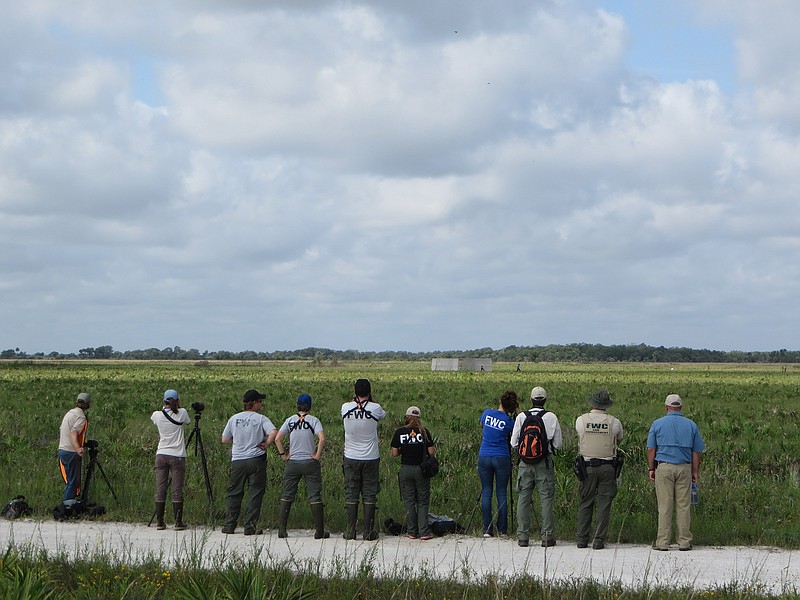ORLANDO, Fla.-Three of the rarest birds in Florida took an extraordinary adventure this week, slipping out of a large pen into the freedom of an expansive, treeless prairie south of Orlando.
The year-old Florida grasshopper sparrows were hatched and raised in captivity, and designated as pioneers in a perilous bid to save their kind from oblivion.
Staffers of the Florida Fish and Wildlife Conservation Commission, the U.S. Fish and Wildlife Service and other organizations lined a dirt road Monday, observing the pen in the far distance as a pair of biologists removed panels from the enclosure.
Then, with a light breeze, clouds of love bugs and an air of worry and optimism, the group waited quietly for an hour for the secretive birds to make their move.
"One flew out," came a text message, followed a short while later by a text suggesting the other two had fled, as they are programmed to do, by running unseen through shrubs and grass.
There are fewer than 80 of the sparrows in the wild-residing exclusively in remote, open spaces of southern Central Florida-and fewer than 70 in captivity.
With such a small population, they are thought of as a blink from oblivion.
In 2015, three males and four females were taken as chicks as the start of what was then uncharted territory; very little was known about how to raise the birds in a cage, including how to turn their eggs, when to expose them to light and what to feed them.
The effort of breeding birds in captivity for release into Florida's environment to stave off extinction was done with Central Florida's dusky seaside sparrows in the early 1980s and with whooping cranes more recently.
The seaside sparrows perished; the cranes survived. The odds for the grasshopper sparrows are still uncertain. But this time, dozens of biologists and veterinarians from conservation groups, universities and government agencies collaborated.
Few birds in Florida have received the attention that has been mustered for the Florida grasshopper sparrow, a bird not much bigger than a golf ball and feathered as plainly as a grocery bag.
Others that do get such intensive care in Florida are superstars: the red-cockaded woodpecker, snail kite and scrub jay.
But the sparrows' release was not without controversy.
Paul Reillo, director of the Rare Species Conservatory Foundation, which raised many of the birds in captivity, has warned that birds in captivity may have ailments that could lethally infect wild birds. He also challenged the timing and technique of the release.
Many in the group at the release said the risks have been analyzed at length, leading to a prevailing worry that inaction is a greater risk for the sparrows.
Craig Faulhaber, avian conservation coordinator for the state Fish and Wildlife Conservation Commission, said several more will be released this year.
The goal, he said, is to sustain the wild population while further research probes what's behind the sparrow's rapid decline.
Like many species of wildlife, Florida grasshopper sparrows have been hard hit by the loss of habitat and the suppression of wildfires that in more natural times kept forests and prairies pruned and healthy.
Yet in a little more than the past decade, something else has attacked the birds.
At the Avon Park Air Force Range adjacent to south Osceola County, there were 300 Florida grasshopper sparrows through the 1990s. Now there is a handful.
Several years of research found that the young and adults are faring reasonably well, but that nesting outcomes are dismal.
Further research learned that corn, black racer and yellow rat snakes, and spotted skunks prey voraciously on sparrow nests.
But those predator species and sparrows have always coincided.
State conservation lands in south Osceola County have been groomed extensively to make them attractive for the sparrows.
That's meant, primarily, a controlled burn every two years, which trims back saw palmettos and promotes a low growth of miniature live oak and chalky bluestem and dozens of other shrubs and grasses where sparrows hide.
The mesh pen used for the release-measuring 60 feet long, 20 feet wide and 8 feet tall-was installed earlier this year after a controlled burn was conducted.
That allowed time for native vegetation to grow so that the "inside of the pen looks like the outside," Faulhaber said.

